
The
President’s Message:
How wonderful it was
that we were finally able to meet in person at the Town Hall.
Adam Katz was our initial speaker and his program was an
outstanding way to restart our meetings.
Well done, Adam!
Our September program
will be presented by Craig Freis who has an authenticated, original
letter from the Civil War.
It was written on May 18, 1861, by the then commander of all the armed
forces, Winfield Scott, and sent to newly appointed Major General
Benjamin Franklin Butler.
This was President Lincoln’s first appointed major general.
The letter Butler received gave him marching orders to take
control of Fort Monroe just a month before the attack on Fort Sumpter.
Craig will discuss all the details of the letter and why it was
important.
I look forward to
seeing everyone at the next meeting.
Gerridine LaRovere
September
14, 2022 Program:
Craig
Freis has in his
collection of original Civil War memorabilia a letter, dated May 18,
1861, written by Winfield Scott to Ben Butler.
In it Scott gave Butler his marching orders to take control of
Fort Monroe and all the Volunteers that were being sent to the Fort.
What makes this letter important is that, not only does Scott
spell out the orders to Butler, he even gives him directives on how to
execute attacks on the enemy with boldness.
Craig will display the letter and explain its history.
August 10, 2022 Program:
It is hard to believe that it has taken so long, but
we finally got permission from the powers that be in Lake Clarke Shores
to resume meeting at the town hall site.
About 30 members and guests came to hear Adam Katz present the
Battle of Ball’s Bluff.
His delivery style was a small departure from the usual battle
story. The talk was divided
into three parts. After a
brief introduction Adam described seven individuals from the cast of
characters, and they all had a story, that saw action on October 21,
1861. Next up was the
description of the battle itself.
The final section delt with the same participants who were
introduced in the opening few minutes.
In the words of the late Paul Harvey, it was a most interesting
“rest of the story.”
 Of
the two commanders of the fight, Adam first described the unfortunate
leader of the Union forces, Brigadier General Charles P. Stone.
BG Stone was born in 1824 in Greenfield, Massachusetts.
Stone’s birth State will figure into the coming fight.
He was a highly intelligent graduate from West Point in 1845,
seventh out of a class of 41.
Stone saw action in the war with Mexico as a young Army officer.
He stayed on with the Army after the war when promotion and pay
were hard to secure.
However, he resigned his commission in 1856 to provide financial support
for his young family. From
every indication he had a good command of military strategy, but a poor
grasp of battlefield tactics. Of
the two commanders of the fight, Adam first described the unfortunate
leader of the Union forces, Brigadier General Charles P. Stone.
BG Stone was born in 1824 in Greenfield, Massachusetts.
Stone’s birth State will figure into the coming fight.
He was a highly intelligent graduate from West Point in 1845,
seventh out of a class of 41.
Stone saw action in the war with Mexico as a young Army officer.
He stayed on with the Army after the war when promotion and pay
were hard to secure.
However, he resigned his commission in 1856 to provide financial support
for his young family. From
every indication he had a good command of military strategy, but a poor
grasp of battlefield tactics.
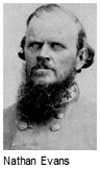 Opposing
Stone that day was Colonel Nathan “Shanks” Evans.
He was the polar opposite of the Union commander, except that he
too graduated from West Point.
Shanks was a drunk and there is no way to sugar-coat that point.
Adam explained his abrasive personality and his passion for
intoxicating beverages, always carrying his “barrelito of whiskey,” led
to constant difficulties with colleagues and superiors.
Col. Evans never changed which led to his going from job to job
fighting with everybody friend and foe alike.
He was like this until the day he died.
As you will shortly learn, Evans carried the day at Ball’s Bluff,
not so much due to his military acumen, but to the blunders that Stone
made. If anything positive
can be said about his action on the field it was that he had the good
sense to move his troops out of the way when the Yankees came across the
river. Opposing
Stone that day was Colonel Nathan “Shanks” Evans.
He was the polar opposite of the Union commander, except that he
too graduated from West Point.
Shanks was a drunk and there is no way to sugar-coat that point.
Adam explained his abrasive personality and his passion for
intoxicating beverages, always carrying his “barrelito of whiskey,” led
to constant difficulties with colleagues and superiors.
Col. Evans never changed which led to his going from job to job
fighting with everybody friend and foe alike.
He was like this until the day he died.
As you will shortly learn, Evans carried the day at Ball’s Bluff,
not so much due to his military acumen, but to the blunders that Stone
made. If anything positive
can be said about his action on the field it was that he had the good
sense to move his troops out of the way when the Yankees came across the
river.
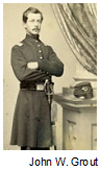 The third player in this drama was Lt. John William
Grout of the 15th Massachusetts.
Like many of Charles Stone’s subordinates, Grout came from upper
class New England stock. He
was, at age 18, a very young leader of men.
His father was a successful business man, and the son enjoyed the
excellent educational advantages given to the young in the enterprising
city of Worcester, MA. He
was a bright boy, and a favorite of his playmates, by whom he was
familiarly known as Willie Grout. It soon was evident that he was by
nature endowed with rare gifts, physically and mentally. The third player in this drama was Lt. John William
Grout of the 15th Massachusetts.
Like many of Charles Stone’s subordinates, Grout came from upper
class New England stock. He
was, at age 18, a very young leader of men.
His father was a successful business man, and the son enjoyed the
excellent educational advantages given to the young in the enterprising
city of Worcester, MA. He
was a bright boy, and a favorite of his playmates, by whom he was
familiarly known as Willie Grout. It soon was evident that he was by
nature endowed with rare gifts, physically and mentally.
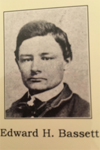 Edward
H. Bassett does not seem to be unique.
He was not an officer, nor did he stand out.
He was in an exceptional unit, 1st Minnesota Regiment.
The 1st Minnesota Infantry
Regiment was the very first group of volunteers the Union received in
response to the South's assault of Fort Sumter at the beginning of the
war. Minnesota's Governor
Alexander Ramsey offered 1000 men to Lincoln immediately upon learning
of the attack on the fort.
He just happened to be in Washington when the news broke.
Edward mustered into service April 29, 1861, the first day the
unit was activated. Richard
Krom, a Great Grandson of Edward H. Bassett, wrote a book about the
regiment called
The
1st MN, Second To None.
The book is based on 218 letters of Private Edward H. Bassett. Edward
H. Bassett does not seem to be unique.
He was not an officer, nor did he stand out.
He was in an exceptional unit, 1st Minnesota Regiment.
The 1st Minnesota Infantry
Regiment was the very first group of volunteers the Union received in
response to the South's assault of Fort Sumter at the beginning of the
war. Minnesota's Governor
Alexander Ramsey offered 1000 men to Lincoln immediately upon learning
of the attack on the fort.
He just happened to be in Washington when the news broke.
Edward mustered into service April 29, 1861, the first day the
unit was activated. Richard
Krom, a Great Grandson of Edward H. Bassett, wrote a book about the
regiment called
The
1st MN, Second To None.
The book is based on 218 letters of Private Edward H. Bassett.
 Next
up is an officer initially referred to only as Colonel Oliver.
This man, born on March 8, 1841 in Boston, was in the 20th Mass. Infantry.
He was highly intelligent and a natural leader of men.
During his senior year at Harvard, he enlisted in the militia,
but with the help of his father he was commissioned in the 20th Massachusetts.
Once again, it will be important to note that this young officer
was from Massachusetts, the state favored by BG Stone. Next
up is an officer initially referred to only as Colonel Oliver.
This man, born on March 8, 1841 in Boston, was in the 20th Mass. Infantry.
He was highly intelligent and a natural leader of men.
During his senior year at Harvard, he enlisted in the militia,
but with the help of his father he was commissioned in the 20th Massachusetts.
Once again, it will be important to note that this young officer
was from Massachusetts, the state favored by BG Stone.
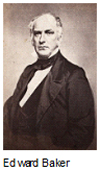 Senator
Edward Baker was the only sitting Senator to serve in a military
engagement. He was, however,
not without military credentials.
During the Mexican–American War, Baker briefly dropped out of
politics and was commissioned as a colonel of the Fourth Regiment of the
Illinois Volunteer Infantry.
Offered a commission as brigadier-general of volunteers on May 17, 1861,
he declined the honor, opting instead to serve as the colonel of the
Seventy-first Regiment, Pennsylvania Volunteer Infantry and
major-general of volunteers 1861.
Baker was a close friend of Abraham Lincoln who, in turned, named
his second child, Edward Baker Lincoln. Senator
Edward Baker was the only sitting Senator to serve in a military
engagement. He was, however,
not without military credentials.
During the Mexican–American War, Baker briefly dropped out of
politics and was commissioned as a colonel of the Fourth Regiment of the
Illinois Volunteer Infantry.
Offered a commission as brigadier-general of volunteers on May 17, 1861,
he declined the honor, opting instead to serve as the colonel of the
Seventy-first Regiment, Pennsylvania Volunteer Infantry and
major-general of volunteers 1861.
Baker was a close friend of Abraham Lincoln who, in turned, named
his second child, Edward Baker Lincoln.
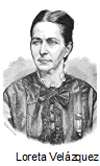 Without
a doubt the most interesting person amongst Adam’s cast of seven is
Loreta Velázquez. Everything
that follows may or may not be true.
That being said, here is what was said early on in the
presentation. She was born
on June 26, 1842 in Havana, Cuba to wealthy upper-class parents.
At the age of seven she was sent by her loving parents to New
Orleans to be with her aunt, a refined lady of independent means.
There she was well educated.
The family expected her to marry a wealthy Spanish-Cuban man.
This was not to be.
At fourteen years old, she eloped with a Texas rancher, much to the
distress of her family and his.
The young couple were financially cut off by both sides. Without
a doubt the most interesting person amongst Adam’s cast of seven is
Loreta Velázquez. Everything
that follows may or may not be true.
That being said, here is what was said early on in the
presentation. She was born
on June 26, 1842 in Havana, Cuba to wealthy upper-class parents.
At the age of seven she was sent by her loving parents to New
Orleans to be with her aunt, a refined lady of independent means.
There she was well educated.
The family expected her to marry a wealthy Spanish-Cuban man.
This was not to be.
At fourteen years old, she eloped with a Texas rancher, much to the
distress of her family and his.
The young couple were financially cut off by both sides.
Loreta and her husband had two beautiful daughters.
In 1859 they moved to St. Louis and by 1861 Loreta found herself
pregnant again. In April
1861 her husband was sent to Florida to train in the Confederate army.
A few months later, she loses the baby.
In the fall of 1861, a fever hits St. Louis and she
loses
both children.
A couple months later her husband dies in a training accident in
Florida leaving Loreta alone once again.
At this point in the presentation Adam Katz left his
characters’ stories, and all of in the audience hanging, to develop what
happened at Ball’s Bluff that fateful day in October 1861.
He reminded us that the Union disaster of Bull Run had taken
place just a few months before in July.
Brigadier General Charles Stone was keen to win a great battle to
show those rebels just what 1,700 Massachusetts boys, and a few soldiers
from Minnesota, could do.
On the night before the battle the good general sent
two companies of the Minnesota 1st across the Potomac
River to see what the Yankees had to face.
Remember, the river was wide and fast flowing at this point.
The mid-western boys had little trouble crossing in small boats
well suited for the task.
The scouting team reported back that they found Confederate cannons
which in reality proved to be "cut cedars, their centers painted black,"
according to Helmi Carr, widow of the great-grandson of Minnesota scout
Pelig Carr. They reported
numerous Confederate tents, which turned out to be trees, but the trees
were blocking the numerous tents of approximately 1,700 Confederate
soldiers. So, the scouting
report was, in essence, very accurate, finding the enemy and gauging the
size and strength of same.
Adam added: “Well done Minnesota!”
Pelig Carr and his
fellow scouts mentioned the fort, the cannons, and tents to General
Stone. Stone reasoned that
since the enemy was one and one half miles from the Federals' projected
landing place there was little to
worry about.
So far so good. He
has done as well as can be expected given the fog of war.
And, the Rebels do not know the Yankees are there.
However, things are about to change.
Adam had a small diorama to explain the geography of
the battle. This map below
will give you a rough idea:

Before the battle you find the Union troops on the far
right and the Confederates hidden in the woods at the very top of the
picture. From right to left
we find the river, the bluff, the field where the Yankees will form up,
a thin line of trees, the place where the Rebels will line up, and the
line of Rebel artillery. The
next morning General Stone sent 350 Massachusetts men stationed on
Harrison’s Island to raid the “small camp” as he thought.
There were actually about 1,700 Confederates well hidden.
This group of 350 men couldn’t find camp.
They sent a message to General Stone.
He sent another 350 Massachusetts men to join the first group
along with Senator Baker to find out more information.
A new scout from the group of 700 men told Senator Baker they
found the army and there were almost 2,000 Confederates so they need as
many men as possible.
Senator Baker brought 1,000 men over in the few
pontoon boats they had on hand.
Understand that pontoon boats are really not boats at all, but
the floats that form the basis of a pontoon bridge.
It took most of the day to ferry the men across the river under
the watchful eyes of Colonel Evans.
When the men were all up and assembled, Senator Baker found that
the Confederate army surrounded them and were hidden in the tree line
with several cannons pointed right at them at almost point-blank range.
And, the Confederate were forcing the Union army back toward the
Bluff which was 80-100 feet at its highest point.
It was a rout.
The Union soldiers were massacred retreating down the bluff,
entering the Potomac, and trying to swim to safety.
Leesburg teenager, Virginia Miller, wrote in her diary: "Of Union
survivors, We saw several wounded...frightfully...
with the blood streaming from his face, from a terrible wound in
the head, some with arms and legs wounded and another with his jaw bone
crushed." A Leesburg,
Virginia resident noted: "Oh, it was terrible and we were in a state of
great suspense and excitement, but had no idea of that a battle was
being fought so near us... The musketry was perfectly terrific and we
could plainly see the smoke and the dead and wounded of our men and the
enemy rapidly increased. It was very mournful to see the ambulances with
the yellow flags, coming and going all the time."
"We've got 'em this time! Oh you infernal Yankees!"
About 160 Union Soldiers drowned, some tangled in
trees along the shore. Many
bodies were fished out of river along the streets of Washington, DC.
Some of the dead were found past Mount Vernon, 50 miles downriver
and 15 miles beyond the Capitol.
At the battlefield the following March, when Federal armies
occupied Leesburg, a Michigan detachment rode to Ball's Bluff, the New
York Times noted, "and buried the whitened bones of the brave Union
soldiers who fell on that field on October last."
The Richmond Whig had a slightly different take on the battle:
"history shows few feats of arms so splendid," and that Gen. EVANS'
"unconquerable troops have achieved a deed that will make their memories
glorious for centuries to come."
As promised, Adam concluded his talk with what
happened to his cast of seven characters.
He began with BG Charles P. Stone whose lot was not a happy one.
He was rightly blamed for the defeat.
He was held in a prison for 6 months under the suspension of
habeas corpus, even though no charges were filed.
Needless to say, this action was very controversial.
After his release Stone returned to insignificant service under
Nathaniel Banks in Louisiana.
After war he was an accomplished engineer on which history rather
soften. Stone was
recommended by General Sherman to join the Egyptian army.
For 13 years he served with distinction under the Pasha of Egypt.
In 1884 Stone became the Chief Engineer for building of the
pedestal and the assembly of the Statue of Liberty.
Following his death, General-in-Chief of the Army, William T.
Sherman, served as one of his pallbearers. Stone was laid to rest, with
full military honors, at West Point.
After Balls Bluff Colonel Nathan “Shanks” Evans was
promoted to the rank of Brigadier General.
However, his bad behavior followed him everywhere he went.
After the 2nd Battle of Bull Run,
August 1862, he got into an argument with BG John Bell Hood.
Hood had old Shanks arrested, but General Robert E. Lee came to
Evan's rescue and overruled his subordinate.
Our boy made a great name for himself at Vicksburg in July 1863,
however while stationed in Charleston, SC he would get in a heated
argument with his superior General Roswell Ripley.
Arrested for disobeying orders, Shanks was acquitted.
Next up in 1864 in Charleston, SC Evans got in a big argument
with General P.G.T. Beauregard, when Gen. PGT called him an incompetent
commander. He never received
another command, but served Jefferson Davis in Richmond.
After the war, he would become a high school principal in
Alabama, but would die a few years later in 1868, from lingering wounds
from the war.
Senator Edward Baker was the only active Senator ever
killed in war after he received a fatal shot to the head.
There is a memorial stone on the battle field, dedicated to him,
but his body was sent to San Francisco for burial.
Loreta Velázquez joined the Confederate Army.
She had a uniform made and disguised herself as a man, taking the
name Harry T. Buford. We
learn this from a book she wrote:
The
Woman in Battle.
When wounded in battle she was discovered to be a female.
Loreta then volunteered to be a spy for the Confederacy.
However, she became disenchanted with the corruption in the South
so she offered her services to the North thus becoming a double agent.
In 1898 during the Spanish-American war to free Cuba, she became
an outspoken critic of Spain.
Loreta was recognized as American hero by Theodore Roosevelt.
And you remember COL Oliver.
He was none other than Oliver Wendell Holmes Jr., an associate
justice of the Supreme Court of the United States from 1902 to 1932.
And now for Edward H. Bassett.
His military service lasted from April 29, 1861 until April 29,
1864. Edward survived the
War fighting in over 20 engagements including Ball’s Bluff. Antietam,
Fredericksburg, and Gettysburg.
Richard Krom noted in his book: “He, like so many of his comrades
would become very successful and a highly-regarded member of his
community and county. His
service to his country in a regiment of American patriots was always a
source of great pride.”
And finally, we come to 2LT John William Grout.
He was killed in the river and Grout's body was recovered on
November 5, 1861, after being washed 35 miles back to Washington, DC.
His remains were identified by the name written on his clothing.
Upon hearing of Grout's death, Henry Stevenson Washburn, a family
friend, wrote
The
Vacant Chair in late 1861.
It is an allegory that describes the pain suffered by the family
of those killed in war during the season surrounding Thanksgiving.
The poem was turned into song by George Frederick Root.
Last changed: 08/22/2022 |

